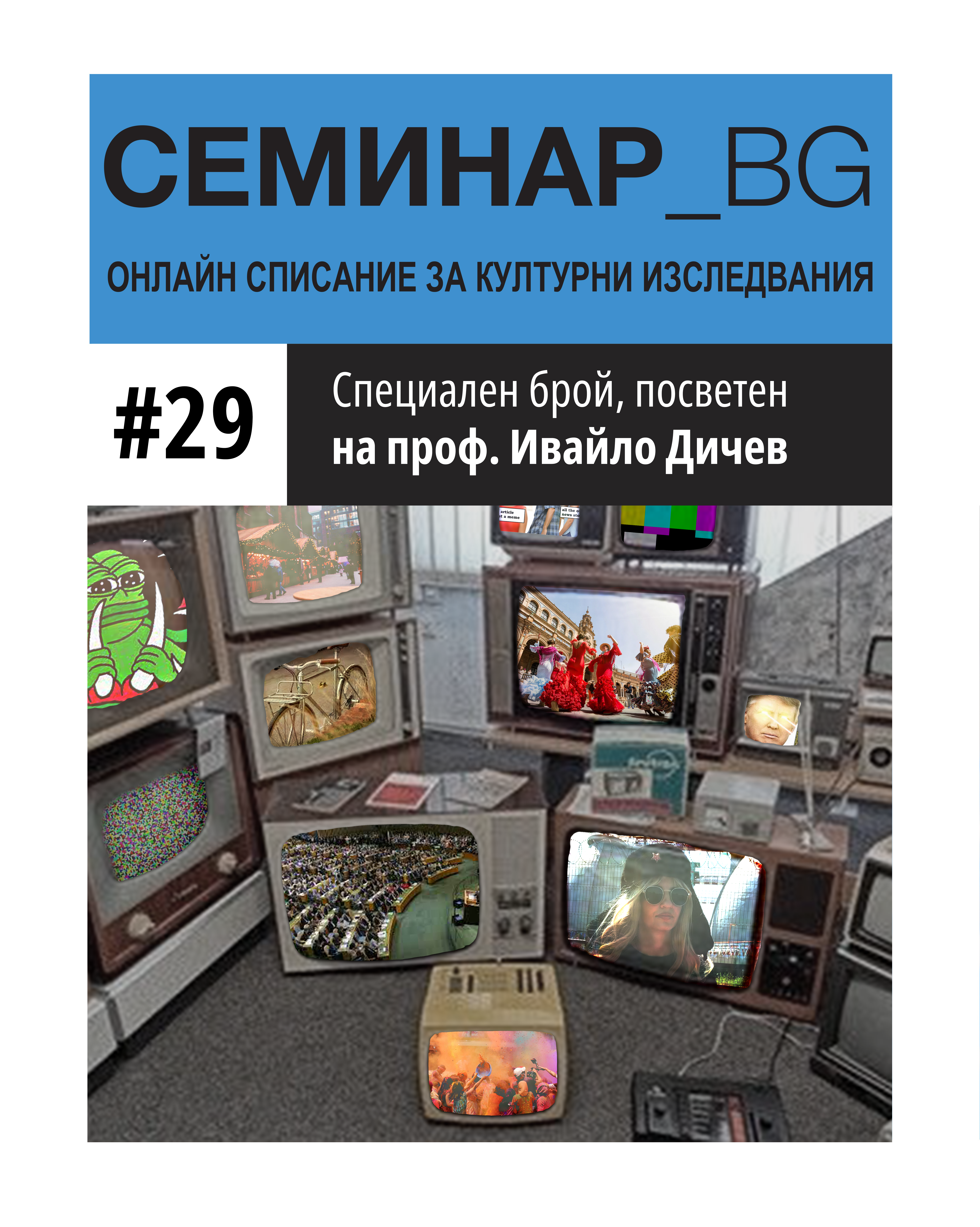Интернет меметиката като код на комуникация
DOI :
https://doi.org/10.60054/SBG.2025.29.214-244Ключови думи :
дигитална меметика, интернет меме, онлайн комуникация, меметичен език, vaporwaveРезюме
Контекстът, в който интернет меметата се развиват, развитието на web 2.0 и амбициите за web 3.0 са неразривно свързани с активно участие и интерективност. Всеки с достъп до компютър и интернет може да се докосне до безплатни научни статии, изображения, музика, видеоклипове и др. и да създава сам (аудио)визуални творения. Текстът разглежда влиянието на интернет меметата върху комуникацията и езика. Изследователските въпроси са по какъв начин комуникацията (on – в дигиталното пространство и off-line-на живо) и езиковостта се е променила, вследствие на влиянието на интернет меметата? Можем ли да говорим за (интернет) меметичен език и какви са разликите между меметичните езикови и традиционните езикови правила? По какъв начин могат да се преведат меметичните езикови системи чрез понятия от лингвистиката? Какви са резултатите от влиянието на интернет меметата върху общуването и езика? Ще бъде направен опит да се отговори на тези въпроси, като ще се разгледат примери за влияние на интернет меметата върху различни сфери: 1. Писменост в дигиталната комуникация. 2. Визуални изображения в сферите на изкуството, графичния и уеб дизайн и аудио-визуални произведения. 3. Човешкото поведение.
Библиография
Генова, Д. 2020. "Интернет мемета и комуникация онлайн". Български фолклор, 3/2020.
Дечева, Т. 2025. "Глич-арт и фотографският образ. Деформации и счупване на цифровите образи". Списание Кино. https://spisaniekino.com/%D0%B3%D0%BB%D0%B8%D1%87-%D0%B0%D1%80%D1%82-%D0%B8-%D1%84%D0%BE%D1%82%D0%BE%D0%B3%D1%80%D0%B0%D1%84%D1%81%D0%BA%D0%B8%D1%8F%D1%82-%D0%BE%D0%B1%D1%80%D0%B0%D0%B7-%D0%B4%D0%B5%D1%84%D0%BE%D1%80%D0%BC%D0%B0%D1%86%D0%B8%D0%B8-%D0%B8-%D1%81%D1%87%D1%83%D0%BF%D0%B2%D0%B0%D0%BD%D0%B5-%D0%BD%D0%B0-%D1%86%D0%B8%D1%84%D1%80%D0%BE%D0%B2%D0%B8%D1%82%D0%B5-%D0%BE%D0%B1%D1%80%D0%B0%D0%B7%D0%B8.html (последно посетен на 27. 02. 2025)
Иванова, Мария. 2022. "Меметата в новините и меметата като новини". Медиалог, 11/2022, 153-184.
Минева, Мила. 2022. „'Да не излиза' или популярната култура като поле за експериментални практики", Семинар_BG, 21. https://www.seminar-bg.eu/spisanie-seminar-bg/broy21/798-da-ne-izliza.html
Перов, Т. 2023. "Едно необикновено животно: Котаракът Румен има 60 хил. последователи във Facebook". BulgariaOnAir. https://www.bgonair.bg/a/36-sutreshen-blok/302044-edno-neobiknoveno-zhivotno-kotarakat-rumen-ima-60-hil-posledovateli-vav-facebook (последно посетен на 13. 02. 2025 г.)
Терзиев, К. 2012. Рекомпозиция- автор, медия и произведение в епохата на дигиталното производство. София: Изток-запад.
Álvarez, David. 2024. Nostalgia Isn't What it Used to Be: On Vaporwave's Glitched, Aspirational Aesthetics. Iluminace. 36. 107-126. 10.58193/ilu.1788.
Baudrillard, J. 1988. Selected Writings, ed. Mark Poster. Stanford, Calif: Stanford Univ. Press
Davison, Patrick. 2012. The Language of Internet Memes. 10.18574/nyu/9780814763025.003.0013.
Douglas, Nick. 2014. It's Supposed to Look Like Shit: The Internet Ugly Aesthetic. Journal of Visual Culture. 13. 314-339. 10.1177/1470412914544516.
Dovydaitis, Gytis. 2021. "Celebration of the Hyperreal Nostalgia: Categorization and Analysis of Visual Vaporwave Artefacts". Art History & Criticism. 17. 113-134. 10.2478/mik-2021-0010.
gamedev, 2022. What is the difference between a bug and a glitch? Is it just the same thing or is there a difference?, Reddit. https://www.reddit.com/r/gamedev/comments/qe4eqi/what_is_the_difference_between_a_bug_and_a_glitch/ (last seen 25. 02. 2025)
Glitsos, Laura. 2018. Vaporwave, or music optimised for abandoned malls. Popular Music. 37. 100-118. 10.1017/S0261143017000599.
Grundlingh, Lezandra. 2017. "Memes as speech acts". Social Semiotics. 28. 10.1080/10350330.2017.1303020.
Jenkins, H., et al. 2006. Confronting the Challenges of Participatory Culture: Media Education for the 21st Century. An Occasional Paper on Digital Media and Learning.
Kostadinovska-Stojchevska, Bisera & Shalevska, Elena. 2018. "INTERNET MEMES AND THEIR SOCIO LINGUISTIC FEATURES". English Language and Linguistics. 2. 10.5281/zenodo.1460989.
Kuipers, G. (2002). "Media culture and internet disaster jokes: Bin Laden and the attacks on the World Trade Center". European Journal of Cultural Studies, 5(4). doi: 10.1177/1364942002005004296
Krustovski, J. 2023. What Is Plunderphonics. https://microgenremusic.com/category/genres/plunderphonics/ (последно посетен на 27.02.2025 г.)
Lessig, Lawrence. 2008. Remix: Making Art and Commerce Thrive in a Hybrid Economy. 10.5040/9781849662505.
Loignon, Guillaume & Messier, Philippe. 2020. Vaporwave pedagogy: Multimodal learning with an internet music microgenre. 16.
McLeod, Ken. 2018. "Vaporwave: Politics, Protest, and Identity". Journal of Popular Music Studies. 30. 123 142. 10.1525/jpms.2018.300409.
Mick-Evans, K. 2019. One Does Not Simply Preserve Internet Memes: Preserving Internet Memes Via Participatory Community -Based Approaches. 10.13140/RG.2.2.18093.54240.
Milner, R., 2016. The world made meme: Discourse and identity in participatory media. (Unpublished doctoral dissertation). University of Kansas, Lawrence, KS. Retrieved from academia.edu
Milner, R. M. 2012. The World Made Meme: Discourse and Identity in Participatory Media. PhD diss., University of Kansas. Accessed March 13 2015. https://kuscholarworks.ku.edu/bitstream/handle/ 1808/10256/Milner_ku_0099D_12255_DATA_1.pdf?sequence=1.
Miltner, K. M. 2014. “'There’s no place for lulz on LOLCats': The role of genre, gender, and group identity in the interpretation and enjoyment of an Internet meme". First Monday, 19(8). https://doi.org/10.5210/fm.v19i8.5391
Miltner, K.M. and Highfield, T. 2017. "'Never Gonna GIF You Up': Analyzing the Cultural Significance of the Animated GIF". Social Media and Society.
Orlovas, Vygintas. 2019.“The Influence of Internet Culture on the Shifts in Aesthetics. A Practice-Based Approach to Vaporwave.” Sovijus 7, no. 1 (2019): 129–137.
Pinto, J. 2017. Cultural Ideas Essay. Vaporwave & Postmodernism: An Analytical Interpretation of Blank Banshee. SAE Institute London.
Semotiuk, O., & Shevchenko, V. 2023. "Making fun of power: political cartoons and memes about President Zelensky. Quantitative and qualitative analysis". The European Journal of Humour Research, 10(4), 82–98. https://doi.org/10.7592/EJHR.2022.10.4.703
Shifman, L. 2014. “The Cultural Logic of Photo-Based Meme Genres.” Journal of Visual Culture 13 (3): 340–358. doi:10.1177/1470412914546577.
Soriano, Ezequiel. 2022. "Internet vernacular creativity. Vaporwave, counterculture and copyright". ISEA2022 Proceedings, (2022): 556-561
Tay, G. J. S. 2014. "Binders full of LOLitics: Political humour, inter net memes, and play in the 2012 US Presidential Election (and beyond)". European Journal of Humour Research 2(4): 46– 73
Vadde, Aarthi. 2017. Amateur Creativity: Contemporary Literature and the Digital Publishing Scene. New Literary History. 48. 27-51. 10.1353/nlh.2017.0001.
Wiggins, B. 2019. The Discursive Power of Memes in Digital Culture. Routlege Studies in New Media and Cyberculture. 52 Vanderbilt Avenue, New York, NY 10017.
Zavala Barreda, Karla. 2018. Dystopian Shopping Malls: Vaporwave and The Ghosts of The Future. Paper presented at Cool Retro Camp Trash, Aesthetic Concepts in Popular Culture, Freiburg, Freiburg University.
Файлове за сваляне
Публикуван
Как да цитирате
Брой
Секция
Лиценз

Публикация с Creative Commons Attribution-NonCommercial-NoDerivatives 4.0 International License.

